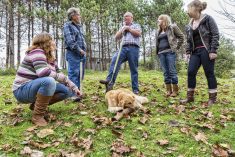Winter is notorious for an increase in aches, pains, illnesses and injuries. Some of this stems from colder temperatures and less sunlight, which can take a toll on our bodies and minds even before hazardous conditions such as snow and ice take effect.
We can’t control the weather, but there are a few things we can integrate throughout winter to best prepare ourselves to adapt and manage this season.
Seasonal nutrition
Read Also

Gentle treatments for pain in the neck
Heading toward year-end, people unknowingly tense up against the cold and busyness, causing neck pain that can often be treated with appropriate support and gentle mobility, athletic therapist Kathlyn Hossack says.
In my experience, many people benefit from shifting their intake of nutrients to suit the season at hand.
In the summer months, choosing lighter meals focused on readily available produce and proteins is appropriate and supportive for many lifestyles. Come winter, those of us residing in colder, northern climates sometimes must get creative to ensure we’re getting the appropriate nutrients.
Food choices may shift to heavier, starchier options due to a limited supply of fresh fruit and vegetables. Supplementing your diet with core vitamins and minerals such as vitamin D (often recommended as sunlight decreases), vitamin C, different vitamin Bs, magnesium and omega-3s when needed and advised by your health-care team can make a big difference when food availability shifts through the season.
Adding spices such as turmeric, cayenne, ginger and cinnamon to your winter meals warms the body from the inside out and can also boost your immune system and support healthy digestion. These spices have anti-inflammatory properties as well and can provide relief for those struggling with joint aches and pains.
Other commonplace kitchen herbs such as sage, rosemary, oregano and basil are also systemically supportive for digestion, respiratory health, cardiovascular health and the immune system.
If you have a garden in the summer, drying your herbs for use in the winter can be a great way to extend their health benefits.
Remember to consult a qualified nutrition expert if you’re unsure of how to maintain a well-balanced diet or eat appropriately considering your health history.
Restorative movement
Finding ways to move your body consistently is one of the best habits to maintain during winter.
Sometimes it can be as simple as committing to take your joints through their range of motion once or twice a day. This can be done when you wake up, as you head off to sleep or even while you’re in bed.
Lying down, I like to start with my feet. Draw circles with your ankles in each direction, slide your heels one at a time toward your bum bending the knees, then lengthen the legs back out, with knees bent and feet resting on the bed or ground, let the knees slowly sway to the left and then to the right, tip and tuck your pelvis forward and backward.
From here, you can roll onto one side keeping knees bent; from this sidelying position, turn your torso and top arm open toward the ceiling, reaching the arm behind you to create a gentle twist. Repeat this for five to 10 rounds before switching to the second side. Then, either coming up to seated or back to laying on your back, shrug your shoulders up and down or draw circles in each direction with the shoulders, draw circles at the wrists in both directions, slowly turn your head to each side and tilt it to each side. Repeat all these movements five to 10 rounds, in each respective direction.
Movements that gently increase your heart rate and breath rate a few times a week can be wonderfully supportive to the body. Movement that challenges our cardiovascular system improves circulation and heart health, and it also keeps joints happy and supports mental wellness.
In my article on dancing in the Oct. 31 issue of Grainews, I explained that moving to music has many benefits and can be done in many situations.
Walking for at least 10 minutes a day, either on cardio equipment or while enjoying the outdoors, has been shown to dramatically improve health maintenance.
For all my clients, I recommend regular balance and co-ordination exercises as part of their movement routines. This can be as simple as balancing on one leg, walking on tiptoes down the hall, or pretending the lines on your floor are a balance beam and walking along it a few times a day.
Balance and co-ordination are important lifelong skills, and practicing some form of them can be an effective preventative for life-changing falls or slips through our winter seasons.
If movement is painful, or you feel overwhelmed about how to integrate it into your life in a meaningful way, consult with a qualified movement-based professional. Athletic therapists, kinesiologists and physiotherapists are experts at integrating movement into lifestyles.
Injuries and illness can’t always be prevented, but moving your body regularly and fueling it well will increase resiliency to help prevent illness and injury and reduce recovery time.















